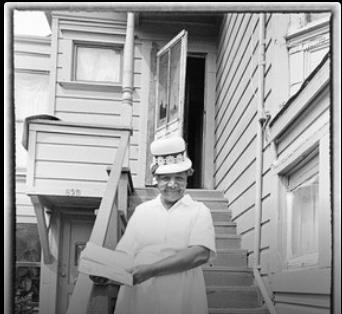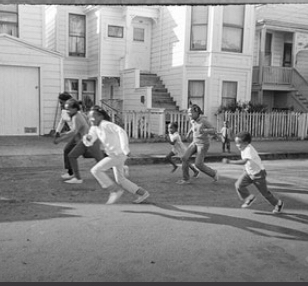People of McElroy - A Photo Essay by Rod Mullen
A conversation with Rod Mullen and Andre James
“Forget your one great image, go out and really spend some time with people, learn about them, and bring back photographs that reflect what you have learned.”
John Collier Jr.
Rod Mullen - I had inherited some money from my father, who died when I was 17, so I took a year to go to the San Francisco Art Institute with the intent of getting a Master of Fine Arts in photography, something which I had taken an interest in while at UC Berkeley, learning how to develop film and print my own pictures. I had two professors at the Art Institute, one being John Collier, Jr., a colleague of Dorothea Lange, Paul Strand and other prominent photographers. Collier is recognized today as a major pioneer in visual anthropology and visual sociology. Of course I learned about this long after my year at the Art Institute, then I just knew he had a really different approach to photography.
McElroy Street
Rod - Since I was living in Oakland and had participated in some civil rights demonstrations while at the University, I began wandering around West Oakland, which at the time was a predominantly African American community. I found one little half block called McElroy Street, and began talking to some of the men, women, and children there, who spent a great deal of time outside their homes, in their yards, on the sidewalks and literally on the street itself.
Rod - I was a 24-year-old white kid with a camera, so I had to figure out a way to ingratiate myself. So, I took a few pictures, went home, printed them in my darkroom, and showed up the next day with the pictures. I repeated this day after day for several months. Since just about everyone likes seeing photographs of themselves I was soon welcomed and more or less integrated into the community.
Rod - I went everywhere—in homes, at meetings, on the street, to jails to bail people out. In some ways I became invisible and no one really cared that I was taking photographs of them, since they got to see them all and keep them.
Andre - In review of your photo essay, I was inspired to do a little research. McElroy Street is only four blocks from Seventh Street where the first Oakland African American middle class community took root in 1937. In 1925, the Brotherhood of Sleeping Car Porters, created by C.L. Dellum, organized the African Americans porters, cooks and waiters to fight for better working conditions and better pay. Finally in 1937, the union won their negotiation with the Pullman Palace Car Company. This first contract between an African American union and a corporation, launched the Oakland black middle class who began purchasing homes on Seventh Street. Just four blocks from McElroy Street.
“In the 1940s, West Oakland’s Seventh Street was hailed as a cultural haven for African-Americans. During the day, it served as a bustling place of commerce hosting a myriad of businesses such as markets, cleaners, restaurants, hotels and gyms. At night, its many nightclubs offered a thriving social scene that drew the hottest names in jazz from around the country. These clubs served as the seedbed that fostered the birth of West Coast Blues. Oakland’s specific location — at the junction of multiple modes of transportation — brought people from around the world to Oakland, especially Blacks from the South. It was these emigrants and immigrants who significantly contributed to the birth of Seventh Street. The ascent of Seventh Street’s prominence coincided with the emergence of a regional African-American middle class.” Rise and Fall of Seventh Street - Written by Jennifer Soliman
Andre - You should know that in the 1950’s, my grandparents ran a coffee shop in this neighborhood. Charles James, a local mechanic, frequented their shop. He was one of those migrants from East Texas. As the secret love child of a recently deceased wealthy Irish landowner and his black housekeeper, Charles was in line to inherit the ranch. He was rushed out of town at 13 years of age to save him from a lynching. He made his way to Oakland, California. Charles and my mom met at that coffee shop (we lived upstairs). That sparked a relationship that lasted for forty-seven years.
Although prosperous at the time, the post war deterioration of that neighborhood is another story.
Rod - By the time I started taking photographs in the fall of 1967, West Oakland had deteriorated into an impoverished ghetto. During the nine months or so that I spent on McElroy Street, the Black Panthers emerged in Oakland to challenge the egregious racism and violence of the Oakland police, and the grinding poverty of those neighborhoods. When Martin Luther King, Jr was assassinated in the spring of 1968, two enraged Panthers attacked an Oakland police station, which precipitated the systematic killing of most of the male leadership of the Panthers over the next few years.
While the Panthers preached “Black Power” on McElroy we engaged in ”Block Power”, cleaning up the neighborhood, building a playground on an empty lot, working with the kids, and really organizing the block.
Rod - It’s one thing to march for civil rights, and quite another to really live with and experience the lives of African American men, women and children, victims of systemic racism in a city where the Oakland police were as racist and violent as any city in the South. I learned about that, but I also learned about the authentic relationships amongst people, the love for children, and the real sense of community where taking care of each other and helping each other was practiced every day.
Rod - There was joy, sorrow, laughter, tears, and a rich tapestry of relationships that ameliorated their struggles. I also saw these neighborhood teens torn between the militant Black Panther activism and the passive resistant attitudes and actions of the older generation on McElroy Street.
Rod - At one point I was told, at gunpoint, “get out of here, white boy, you don’t belong.” That didn’t end my involvement, but it signaled a real change in the relationship I had developed. During those the last few months, I was getting involved with Synanon, and saw a similar population of disenfranchised people living in a community devoid of racial prejudice, addiction, and hopelessness. My experience on McElroy Street, both good and bad, was the precursor for moving into Synanon with my family. It was the equivalent of a Peace Corps experience for me, a way of living out the principles that I had been developing---but much more. Now that is another story.
About TOTA
TOTA.world provides cultural information and sharing across the world to help you explore your Family’s Cultural History and create deep connections with the lives and cultures of your ancestors.























